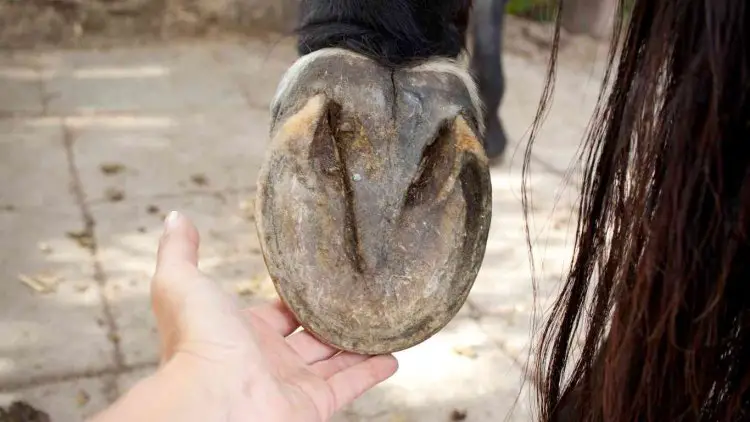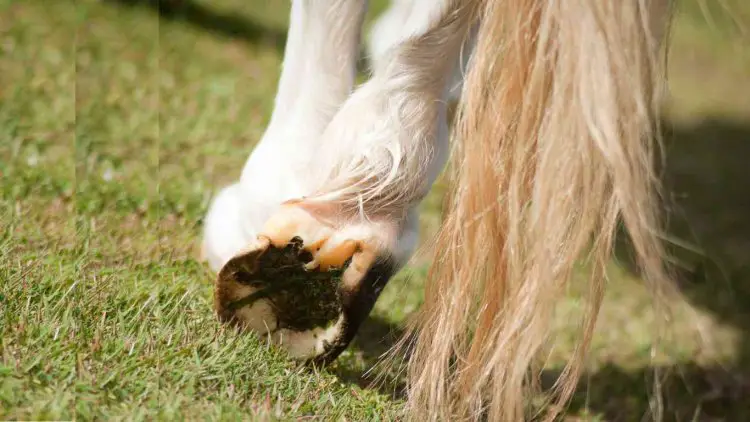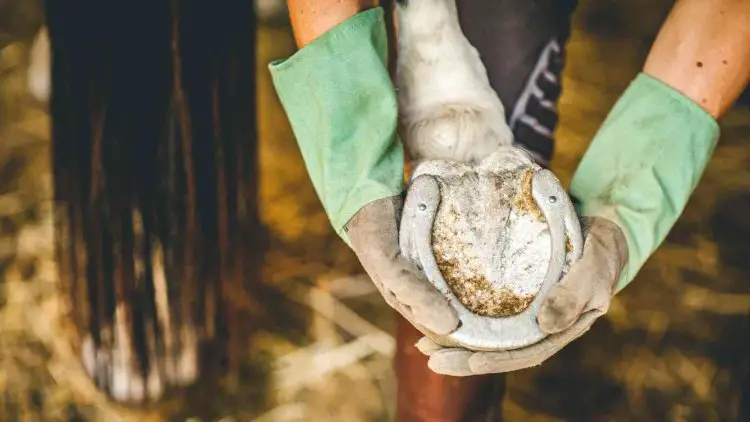Degloved Horse Hoof: Causes, Symptoms, Treatment & Care
This blog post ventures into the world of 'degloved horse hooves', illuminating a rather painful ordeal our equine friends can suffer. Understanding what a degloved hoof means and its consequences for the horse's wellbeing, we take you step by step through the cause, degloving symptoms, and treatment for the degloved hoof. From simple accidents to traumatic incidents or laminitis, we explore the multitude of factors leading to the degloving of horse hoofs. Understanding the seriousness of this condition, we introduce preventive measures to reduce the chances of such injuries, underlining the importance of a safe environment, regular hoof checkups, and the irreplaceable role of a skilled farrier. Finally, we shine a light on potential complications, like infection or longer healing times, seeking to prepare horse owners and handlers for the road to recovery from degloved horse foot injuries.

Table of Contents
What is Degloved Horse Hoof?
Introduction For those unfamiliar with the term, a “degloved horse” may sound a bit peculiar. In fact, the term refers to a horse suffering from an injury where the hoof's outer shell or cap is removed, similar to how a glove might be pulled off a hand. This is arguably one of the most serious injuries horses can experience given the importance of hooves for their locomotion, and how considerably painful such an injury can be. Therefore, understanding such injuries is crucial for horse caregivers.
A degloved horse is quite literally a horse with the entire hoof capsule separated from the foot. Imagine wearing a shoe and losing it suddenly, leaving your vulnerable foot exposed. That's similar to what our equine friends experience. It's a serious situation because the hoof cap plays a vital role in protecting the horse's feet.
Understanding degloving injuries and their treatments isn't only crucial for veterinarians and equine health professionals but also for horse owners and lovers like you. Knowledge can literally make the difference between a quick recovery and prolonged suffering for our equine friends.
Causes of Degloving Injuries in Horses
Many factors can lead to this harsh reality, let's go over some of them.
Accidents:
Horses are powerful, majestic creatures with a love for speeding around or sometimes just exploring their environment. This, unfortunately, renders them susceptible to accidents. These might involve snagging a hoof on a fence, getting a shoe wedged in a gap, or crashing into a structure. Particularly at high speeds, the resulting impact could induce severe injuries, including the degloving of the hoof.
Trauma:
Traumas, whether resulting from falls, collisions, fights, or transportation incidents, can all contribute to the likelihood of more complex injuries, including degloving.
Laminitis:
Do you know what Laminitis is? It is a severe condition that can weaken the link between laminate - the tissue connecting the hoof cap to the underlying bone, disrupting the hoof’s overall structure. It's caused by disrupted blood flow to the hoof, significantly weakening the hoof-to-bone connection. In severe cases, it can lead to complete separation of the hoof cap -yes, a degloved horse hoof. Oftentimes, a degloved horse hoof is either a symptom of poor overall hoof health or Laminitis.
Common Scenarios Leading to Degloving In Horses:
Hoof health is not to be taken lightly. Neglected hoof cracks, untreated abscesses, thrush, or generally poor hoof hygiene can all create fertile ground for serious issues like degloving to occur. In general, instances of degloving also increase with a horse's age and work intensity.
Signs and Symptoms of a Degloved Horse

The most apparent sign of a degloved horse is the presence of open wounds with exposed muscles, bones, or tendons. Beyond the obvious visible wounds and tissue damage, often show noticeable behavioral changes. They become more sensitive and reluctant to perform certain gaits and maneuvers, which is understandable considering their discomfort and pain.
Degloving injuries are excruciatingly painful for horses. Pain is pain, whether in humans or animals. A horse in pain will be reluctant to put pressure on the limb, will seem seriously lame, and may show signs of severe discomfort such as heat and swelling in the hoof.
Related: Understanding Roach Back in Horses: Causes & Care
Treatment Options for Degloved Horses
If you suspect a degloving injury, it's crucial to seek professional veterinary help immediately. Also, immediate first aid is paramount to prevent further harm. This might involve gently cleaning the wound, protecting the hoof from further injury, and providing pain relief medications under vet supervision.
In some cases, surgical intervention might become a necessity. Coupled with carefully managed wound dressings and diligent pain management, the recovery process starts. The stint in rehab is hard on our equine friends. But with patience, perseverance, and top-quality care, many can reclaim their former vigor.
Complications and Risks
Every medical scenario is not without risk. Degloving carries the risk of infection post-surgery, and healing might take longer than expected. The healing process for degloving injuries can be slow and unpredictable. Factors such as the horse's overall health, the severity of the injury, and the quality of wound care can all impact the rate of healing. Some horses may take months to fully recover.
Though we wish the path to recovery was smooth, it comes with its own bundle of complications. An infection following a severe injury bodes ill for our already suffering friends. Even with successful surgery, delayed healing could result in long-term hoof abnormalities. In certain cases, a hoof that has healed might never regain its original form, leading to permanent lameness in horses.
Preventing Degloving Injuries in Horses

Ensuring a Safe Environment and Proper Nutrition:
To understand prevention, let's walk in the soft hay-filled shoes of our horse for a bit. By ensuring a safe environment free from hazardous materials or structures, we reduce the odds of accidental hoof injuries significantly.
Now think of your diet and how it affects your health. In the same way, nutrition sustains our equine companions. A balanced diet, fortified with essential vitamins and minerals, helps generate a healthier and stronger hoof structure.
Regular Hoof Checkups:
One might think, "Hey, horses are super durable!" And yes, they are, but no one is beyond care. Regular hoof checkups play a crucial role in warding off potential hoof problems. Cleaning the horse's hooves daily helps to spot trouble early. Detecting early signs of white lines, cracks, abscesses, thrush, or the dreaded laminitis could potentially save our equine friend a great deal of pain and us, a whole lot of stress.
The Role of Farriers:
Now, we come to our unsung heroes - the farriers. They're the skilled blacksmiths of the horse world, specializing in hoof care. Just as we go for regular check-ups at the doctor's office, we must ensure our horses do too, especially when it comes to taking care of their fancy feet! Your friendly neighborhood farrier is the go-to person for keeping those hooves in tip-top shape. They're always on guard—keeping an eye out for early signs of issues that could disrupt the healthy trot of our animal friends.
FAQs
Can a horse regrow a hoof cap?
Yes, they can! But it's not an overnight journey. A hoof cap takes quite a while to grow back. It's kind of like a year-long project, intensely dependent on the horse's health and its age. It's all about spotting possible infections early and making sure the hooves don’t go out of shape through the process.
Can a horse survive a Degloved hoof?
Sure they can! It's a pretty serious injury that needs immediate attention from a vet, but with the right care, a horse can recover from a ‘degloved hoof’. The truth is, getting better can take quite a long time and can sometimes be complicated, with additional risks such as infection, delayed healing, and long-term consequences like permanent lameness, but it is definitely possible.
Why is a horse's hoof Degloved?
A horse's hoof can be degloved as a result of severe trauma or accidents, such as getting the hoof caught in a fence or other structures. Certain health conditions, like laminitis, which affects blood flow to the sensitive and insensitive laminae in the hoof, can also significantly increase the risk of degloving. Poor overall hoof health due to untreated conditions like abscesses, cracks, thrush, and inadequate nutrition can also contribute to degloving.
What happens when a horse's hoof comes off?
Well, think of losing a protective shield. Once the cap comes off, all the delicate structures and tissues stand exposed. It's painful—imagine those poor creatures not being able to trot along because of the discomfort. The horses may have to be put through a series of treatments, possibly including surgery, wound care, pain management, and a long stretch of recovery. The new hoof cap could be different from the original one, potentially affecting the horse's movement even after they've recovered from the injury.
Conclusion
In a nutshell, a degloved horse is seriously injured with a detached or damaged hoof cap. It results from a variety of factors ranging from accidents, trauma, laminitis, or little hoof health care. But it’s possible to prevent them with the right preparation, safety measures, and training. Understanding the causes, symptoms, treatment, and prevention of degloving injuries in horses is key to ensuring their wellbeing. It equips horse owners, handlers, and trainers with the knowledge to ensure the animal's comfort, safety, and overall health. Remember, if your four-legged friend is ever involved in such an unfortunate event, a vet should be your first call. Here's to hoping you and your horse can avoid such unpleasant situations, and gallop together towards sunnier horizons.
What's Your Reaction?

















